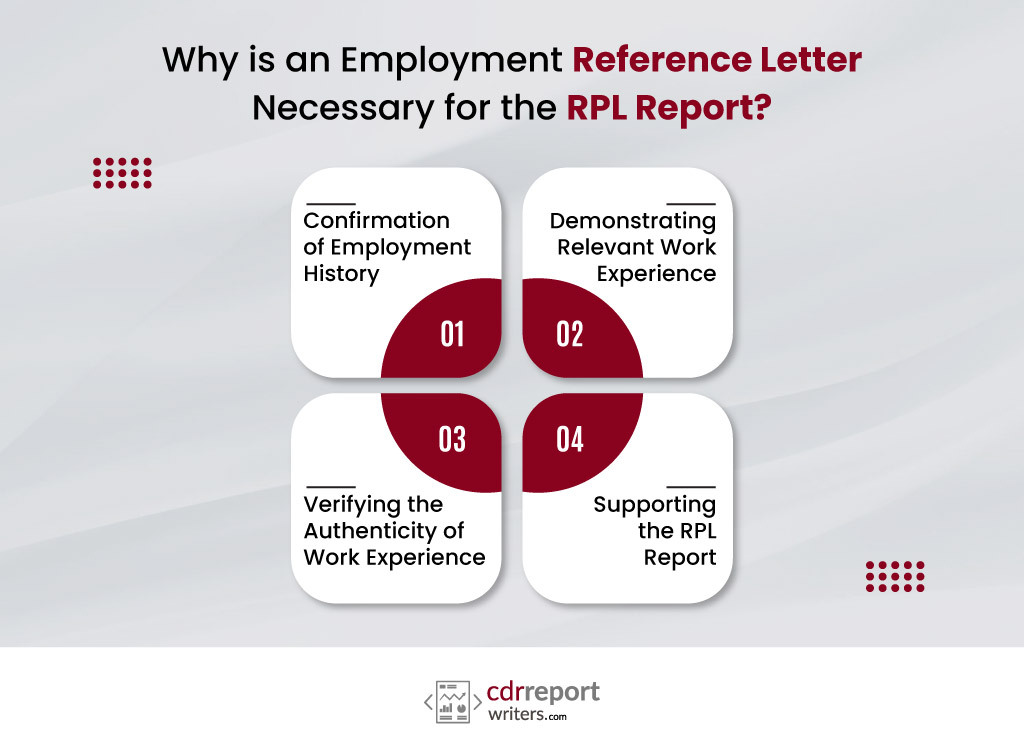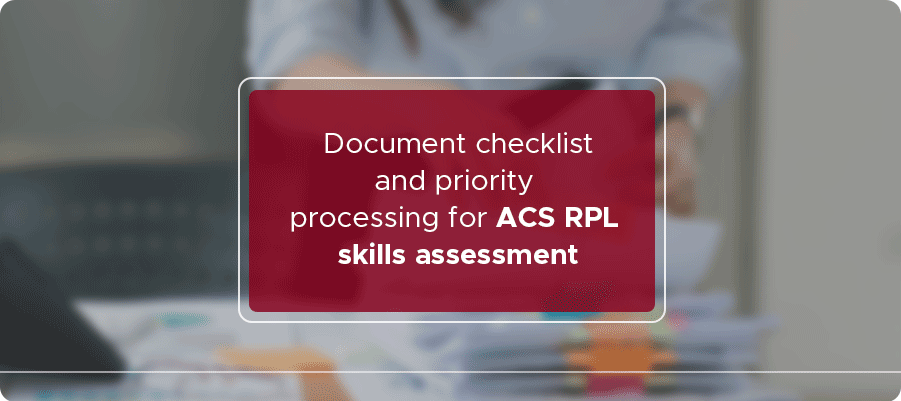
Why is an Employment Reference Letter Necessary for the RPL Report?
Do you want to apply for Skilled Migration to Australia as an ICT expert but need to gain the necessary qualifications? Then an excellent work reference letter may assist you in demonstrating your expertise and talents in the chosen area.
An employment reference letter or recommendation letter is a written document that describes a person’s professional talents, work, and experiences while stressing their ability to execute specific tasks. Candidates without an ICT qualification must submit an RPL project report and a job recommendation letter to the Australian Computer Society (ACS).
As a result, applicants with non-ICT degrees may demonstrate their competence in the ACS Skills Assessment and obtain good scores. ACS assesses candidates’ talents based on their knowledge, skills, and work experience.
What is an Employment Reference Letter?
An employment reference letter is a document written by an employer that provides information about an individual’s work experience, skills, and abilities. It is typically requested by the RPL assessing body to confirm the applicant’s employment history and the relevance of their work experience to the qualification they are seeking.
Why is an Employment Reference Letter Necessary for the RPL Report?
Below are some reasons why Employment Reference Letter is necessary for the RPL Report:

-
Confirmation of Employment History
One of the main reasons why an employment reference letter is necessary for the RPL report is to confirm the applicant’s employment history. The letter should contain details such as the job title, job description, duration of employment, and any other relevant information.
The assessing body requires this information to ensure that the applicant has the required work experience in the field pertinent to meet the competency standards necessary for the qualification.
-
Demonstrating Relevant Work Experience
Another reason an employment reference letter is also necessary for the RPL report is to demonstrate the applicant’s relevant work experience. The assessing body requires evidence that the applicant has the essential skills and knowledge in the field pertinent to meet the competency standards necessary for the qualification.
The letter should provide details of the applicant’s work experience, including any tasks or projects demonstrating their skills and knowledge.
-
Verifying the Authenticity of Work Experience
An employment reference letter is also necessary to verify the authenticity of the applicant’s work experience. The assessing body requires this information to ensure the applicant has gained work experience through legitimate means. The letter should get written on company letterhead and signed by the employer to confirm its authenticity.
-
Supporting the RPL Report
The employment reference letter is an important supporting document for the RPL report. It provides additional evidence of the applicant’s work experience and skills, which can help to strengthen the RPL report. The letter can also clarify any uncertainties or discrepancies in the RPL report.
Learn More: Pathways for Migration Skills Assessment ✏️✏️
Employee reference code Australia
To show their competence and be favorably rated in the ACS Skills Assessment, candidates with non-ICT degrees or insufficient ICT skills must submit the RPL project report to the Australian Computer Society (ACS) with an employment reference letter.
It demonstrates the candidate’s work experience and expertise in the profession. It has a detailed work history of at least seven years in the selected occupation, qualifying it for the ACS RPL Application. The following factors influence RPL reports:
- On-the-job training, as well as any work done outside or inside Australia ( paid and unpaid)
- Hobbies, sports, leisure activities, and community or volunteer work are other qualifications earned in Australia or overseas.
Things to Consider while writing ACS Employment Reference Letter
Consider the following scenario: you want a well-written employer reference letter for the ACS RPL Report. In this situation, CDRReportWriters provides a place to get the best RPL Report Writing Services and reference letter samples for your reference. Remember to underline essential points while drafting your ACS Employment Reference Letter.
Detailed Information About your Job
List the details you’ll need to include in your work experience. It is completely forbidden to use content from online samples. Any job experience you offer must be professional and linked to the specified occupation categories according to the ANZSCO Code.
Inadequate Work Experience Details
You must have sufficient work experience to fulfill the skill level criteria before submitting an RPL Report for the ACS RPL Assessment. Only those employees who meet the required skill levels will be considered skilled and eligible for migration points. Remember to describe your job specifics and activities accomplished when providing an employment reference, highlighting skill areas.
Use Valid Signatures
The employer or authorized personnel of the company must verify the job reference letter. Give specifics about yourself, including your duties and responsibilities, status, and work in your chosen sector. Using a forged signature or letterhead will fail.
Learn More: Temporary Graduate Visa Subclass 485 ⏱⌛️
Basic Guidelines for Writing an Employment reference letter
To be considered acceptable for migration skills evaluation, work experience must be at an expert ICT level and related to the selected occupation. The rules for writing employment reference letters are as follows:
- DD/MM/YYYY date format
- Full-time vs. part-time hours worked, as well as weekly hours worked.
- On the organization’s letterhead, the approved individual’s name appears (digital signatures are acceptable and must be verifiable)
- Duties carried out throughout your job.
- Position in the given field of work
- Indicate the nation in which you did the work.
- If appropriate, you should note previous roles and responsibilities.
Best Tips to Write an Employment Reference Letter
- You can list as many job responsibilities as you like in your reference letter. However, be sure that the duties you’re doing are related to the job you’ve chosen. For the experience to be closely connected to the nominated occupation, at least 65 percent of the responsibilities specified in the employment reference must be relevant to the proposed field (ANZSCO). If the concern isn’t acceptable owing to a lack of information, EA will mark it as “Not suitable.”
- Your employer must sign an Employment Reference Letter. The referred person’s name, position, and contact information must get included.
- Before applying for the Skills Assessment, ensure you have enough job experience. ACS has established the minimum work experience necessary to satisfy the skill level standards.
- All references must include detailed information from your employer about the tasks you completed and the talents you used on the job. It will mark references as “unacceptable owing to a lack of information” if they don’t include precise specifics about your responsibilities.
- An authorized notary shall certify the reference as a true copy. Only the certified copy of the work reference letter gets considered for the ACS Skills Assessment.
- A full-time job gets defined as working at least 20 hours per week. So, if you’re referring to a full-time or part-time job, satisfy the requirements and specify the working hours in the letter.
- Employees with prior work experience who do not reach the required skill level are not deemed skilled and eligible for migration points. And your RPL will be marked as “unsuitable due to insufficient experience.”
- Your work experience should be at a professional ICT level and relevant to the chosen occupation to be deemed acceptable (ANZSCO).
- Work experience obtained as part of the qualification is listed as “Concurrent Employment” and is not considered skilled employment.
- Mention each employee’s start and end dates in a DD/MM/YY format in an employment reference letter. If your employment is “Current,” state the term “To Date” and include the date you wrote the reference.
- In the reference letter, have your actual job and experience. Never plagiarise from other sources.
- Remember to provide the name of the nation where you performed the job. If you worked for one firm in numerous countries, your employment reference must list the precise dates and places where you worked.
- Because an employment reference is proof of your competence, strive to be more specific to the specified occupation and explain the job duties and obligations you accomplished in the field that shows your vital areas.
Learn More: Skilled Employer Sponsored Regional Visa (Subclass 494) 📖📖
Seek Professional Advice from CDRWritersAustralia
A skilled ICT specialist from CDRReportWriters can assist you in preparing your RPL report. Contact CDRReportWriters if you need help writing an employment reference letter. We have a qualified team of experts that can write ACS-approved reference letters that are 100 percent real and original.
Conclusion
An employment reference letter is a requirement for the RPL report. It confirms the applicant’s employment history, demonstrates their relevant work experience, verifies the authenticity of their work experience, and supports the RPL report.
If you are an applicant seeking an Australian ICT qualification through RPL, request an employment reference letter from your employer to assist with your application. If you are an employer writing an employment reference letter for RPL, include all relevant details, be specific, use professional language, and verify the letter’s authenticity.
By following these tips, you can ensure that your employment reference letter meets the RPL assessing body’s requirements and helps support your application for an Australian ICT qualification.
In summary, an employment reference letter is an important document that provides evidence of an applicant’s work experience and skills in the relevant field. The RPL report must confirm the applicant’s employment history, demonstrate their relevant work experience, verify the authenticity of their work experience, and support the RPL report.
If you are an ICT professional seeking an Australian qualification through RPL, request an employment reference letter from your employer and provide all the necessary details to support your application. Doing so can increase your chances of successfully achieving your desired qualification and advancing your career in the ICT field.





